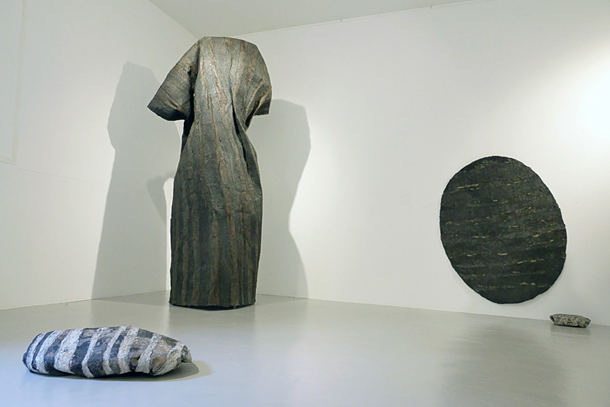■WORKS■

素材表現が生む新たな世界との出会い
21世紀、日本において美術がアートという表現に取ってかわって久しい。かつて美術は絵画と彫刻を中心とした表現とされていたが、インスタレーションや映像、パフォーマンスといった環境芸術や時間芸術を取り込むことによって美術という概念では収まりきれないものとなり、アートという表現がふさわしく一般化されていったといえる。今日、人々が美術=アートを受容する感覚器官は視覚だけにとどまらなくなった。
ご周知のように、人の感覚機能には視覚・聴覚・触覚・味覚・臭覚がある。いわゆる五感と言われるものだ。美術作品は視覚芸術であるという範囲にとらわれがちだが、アーティストは制作において視覚だけではなく五感を駆使して芸術作品を創造している。アーティストは鑑賞者に理解とコミュニケーションの方法として五感を要求してきた。さらに五感の身体性の拡張こそが現代芸術を興味深いものにしてきたてといえよう。アートという概念そのものを拡大するには身体性の拡張を必要としてきたのだ。
アーティスト友田多恵子は「触覚への強い関心が制作の動機です」と記す。さらに「言葉を超える感覚こそが生の証と言えるでしょう」と、五感の中でも触覚機能の優位を伝える。
西洋世界では視覚と聴覚は対象から離れても成立するため、他の感覚より優れたものと位置付けられ、伝統的に視覚および聴覚に関わるもののみが芸術とみなされてきたようだ。美術と音楽、詩がこれにあたる。古代ギリシャで詩は即興で創作され朗読された。
感覚機能の中でも触覚に対するこだわりは日本の工芸、特に陶芸にみられる。器を手に取り愛でる行為がこれまで日本の陶芸を発展させ展開させてきた。これまで日本人は触れるという行為で世界を認識してきたと考えられる。見たり聞いたりするだけでなく、物に触れることで世界を体験し、再確認をしてきた感がある。
経験により触覚体験は物に触れずにイメージすることができるようになるようだ。視覚による触覚性があるとすれば、目で物質の表面を愛でることも可能だといえ、視覚が触覚性を備え持つのだ。
友田作品の特徴のひとつともいえる岩肌のようなゴツゴツ、ゴワゴワした触感から、人は過去の経験から生まれてくるイメージによって見た目に惑わされる。友田作品は、重厚に見えて実は驚くほど軽やかなのだ。素材は紙でできていて、彼女の紙という素材へのこだわりはなみならぬ。溜め漉きという技法で楮(こうぞ)を原料に独自の紙を作る。繰り返し紙を漉き自然乾燥を重ねることで堅牢な紙が誕生する。それらの行為は彼女の物質や素材への信仰ともいえはしまいか。作品制作に使われる素材の紙は、日本人の心に訴えかけてくる未知の力への信頼ともいいかえられる。自然から感じ取る未知の力を受けて放たれるともいえよう。これは日本人が持つ自然観と関係しているともいえる。豊かな自然環境から生まれた多神教と自然が結び、自然を宿す神々は人々に恵みを与えてくれるというものだ。
友田は紙を岩肌のような物に変換させことで紙に対する新たなイメージを生み出し、紙という素材の可能性の追求している。また一方、友田の作品は素材表現の可能性を探求するだけでなく、その空間性は作品の存在感が展示された環境空間を変貌させる力を持つ。
素材のそのものが持つ力を友田が引き出す時、私たちは物質としての存在感を持って迫ってくる作品の素材が紙であるということを忘れ、魅了される。空間に浮かび上がる岩のような作品は、超現実的であり驚き持って人々に視覚の曖昧さをただす。
古来、紙は人類の暮しに関わる大切な素材であり、日本の和紙の歴史は1400年の時を紡いできた。ここでもっとも重要なことは、友田が自らの文化背景に根ざして日本の伝統と歴史を踏まえて、紙という素材を現代によみがえらせ、世界に発信している点にあるといえよう。
加藤義夫(美術評論家/宝塚市立文化芸術センター館長/大阪芸術大学客員教授)
Encountering the World Anew Through Expressive Power of the Material
In 21st century Japan, the English loan word “art” has long been used in place of the Japanese bijutsu (fine art). In the past, bijutsu mainly referred to painting and sculpture, but it is too limited a concept to encompass environmental and temporal media such as installation, video, and performance, and the term “art” is recognized as more appropriate and has come into general use. And today, the sensory organs with which we appreciate art are no longer limited to the eyes.
Of course we have five senses––sight, hearing, touch, taste, and smell. When we talk about bijutsu, it tends to be limited to works perceived through the eyes, but when we speak more broadly of “art,” it includes what artists make using not only sight, but potentially any of the five senses. Artists call on appreciators to use all their senses as means of understanding and communicating, and extension of the physicality of the five senses has made contemporary art more exciting. This extension was necessary in order to expand the concept of art itself.
The artist Tomoda Taeko has written that “a strong interest in tactile sensation motivates my production of art.” In addition, she has referred to the superior position of the sense of touch among the five senses, saying “I believe it is our senses that transcend words that prove we are alive.”
In the Western world, sight and hearing have traditionally been regarded as superior to the other senses in that they function even at a considerable distance from the thing being perceived, and it seems that only those arts relating to sight and hearing have historically been granted the lofty status of Art, including visual art, music, and poetry. In ancient Greece, poetry was improvised and recited aloud.
Among the senses, tactile sensation is of particular importance in Japanese decorative arts, and ceramics in particular. The act of picking up and appreciating a vessel in the hands was essential to the development and advancement of Japanese ceramics. It has been suggested that the Japanese largely apprehend the world through the sense of touch, and there is a sense that we experience and reaffirm the world not only by seeing and hearing, but also by feeling the things around us.
Past experiences enable us to imagine tactile sensation without actually touching anything. If there is such a thing as tactility through the sense of sight, then it is possible, so to speak, to feel the surfaces of materials with the eyes.
One characteristic of Tomoda’s works is their rough, uneven tactile quality, reminiscent of the surfaces of rocks, which beguile the viewer through images emerging from past experiences. Tomoda’s works appear heavy and dense, but are actually astoundingly lightweight. Her material is paper, and she has an extraordinary commitment to it. Tomoda uses the traditional papermaking technique of tamezuki, with the kozo (paper mulberry) plant as a raw material. This cumulative process of repeatedly straining and air-drying paper pulp results in thick, sturdy paper. The practice seems to represent her faith in substance or in material, and the use of paper not just as an underlying surface but as the material for the works themselves can be seen as belief in the material’s mysterious power to seize the hearts of Japanese viewers. It can also be seen as absorbing and releasing mysterious power from the natural world, and this can be said to relate to the Japanese view of nature. There is a connection between nature and indigenous polytheism which arose from a rich natural environment, with deities dwelling in the natural world bestowing blessings on people.
Tomoda explores paper’s possibilities by transforming it into something resembling a cliff face, overturning conventional images of paper as a material. However, her works not only investigate the expressive potential of the material, but also have a spatial presence capable of transforming the environment where they are exhibited.
When Tomoda draws forth the intrinsic power of the material, we are fascinated and forget it is paper that is used to create these pieces which assert their physical presence so dramatically. The boulder-like works emerging in space are hyperreal and surprisingly capable of rectifying the ambiguity of our vision.
Paper is a crucial material that has been part of our lives since ancient times, and the history of Japanese washi paper goes back 1,400 years. What is most important here is the way Tomoda breathes new life into paper in the context of Japanese tradition and history, rooted in her own cultural background, and presents it to the world.
Kato Yoshio
Art Critic
Director, Takarazuka Arts Center
Guest Professor, Osaka University of Arts